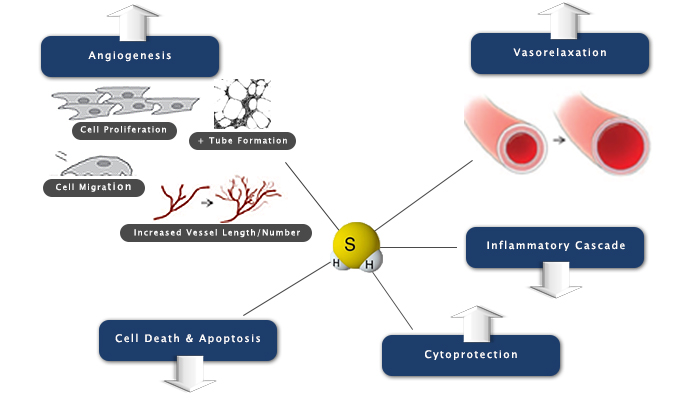
News
October 2025 Exhalix submitted a manuscript for publication in the Journal of Biological Engineering entitled “A Novel Device for On-Demand Hydrogen Sulfide Generation In-Situ to Increase Tissue Perfusion to Chronic Wounds”.
September 2025 Exhalix received a Phase I SBIR award from NCATS focused on development of its Genie:S platform technology.
August 2025 Exhalix received a Phase I SBIR award from NIDDK focused on Kidney Preservation.
January 2025 TAGS Medical was spun out of Exhalix LLC for commercialization of TAGS™ technology.
June 2024 Notice of intent received for a new NIH SBIR Phase I award on hydrogen sulfide delivery device.
May 2024 Abstract submitted for presentation at the Hypertension 2024 meeting on “Transcutaneous Hydrogen Sulfide Measurement as a way to Evaluate Skin Blood Flow.”
May 2024 Abstract submitted to the AIChE 2024 Annual Meeting entitled “An in-Situ Hydrogen Sulfide Synthesis and Delivery Technique for Treatment and Healing of Chronic Wounds.”
April 2024 FDA Q-Sub meeting to discuss and receive guidance on its TAGS™ technology regulatory pathway.
February 2024 First office action received on “Hydrogen Sulfide Delivery Device” patent application, PCT/US2023/077974.
October 2023 New patent filed on “Hydrogen Sulfide Delivery Device”, PCT/US2023/077974.
August 2023 Exhalix awarded SBIR Phase II funding for topical application of its HEALS™ technology.
June 2023 New publication on clinical results of TAGS™ appeared in the Journal of Vascular Surgery Cases, Innovations, and Techniques: New Techniques, Lower Extremity Chronic Arterial Disease, Volume 9, Issue 2: https://www.jvscit.org/article/S2468-4287(23)00010-2/fulltext.
February 2023 European Patent No. 3242596 issued for TAGS technology.
October 2022 Exhalix filed a patent application # 63/420454 in the U.S. on ReLIS™/HEALS™ with the USPTO.
September 2022 Publication on early clinical results of TAGS appeared in the Journal of Sensing and Bio-Sensing Research, https://www.sciencedirect.com/science/article/pii/S2214180422000526.
August 2022 Exhalix received a Phase I SBIR grant from National Institute of Aging to develop and test in collaboration with the UNM School of Medicine a prototype of ReLIS for at-risk surgical wound therapy.
July 2022 Exhalix received EU approval of its patent on TAGS.
June 2022 Exhalix received notification of funding from the National Heart Lung and Blood Institute Commercialization Readiness Pilot (CRP) program to further advance TAGS productization and clinical trials in collaboration with the UNM School of Medicine for application in diagnosis of peripheral artery disease.
June 2021 Exhalix received a Phase I SBIR grant from National Institute of General Medical Sciences to develop and test in collaboration with the UNM School of Medicine a prototype of the HEALS technology for treatment of hard-to-heal chronic wounds.
December 2020 Exhalix granted US Patent # 10,856,790 on “Transdermal Sampling Strip and Method for Analyzing Transdermally Emitted Gases.” https://patents.google.com/patent/US20210068719A1/en
Learn More
Additional Information
1. B. Matheson, R. Osofsky, D. Friedrichsen, B. Brooks, J. Giacolone, M. Khotan, R. Shekarriz, V. S. Pankratz, E. J. Lew, R. Clark and N. Kanagy., “A Novel, Microvascular Evaluation Method and Device for Early Diagnosis of Peripheral Artery Disease (PAD) and Chronic Limb Threatening Ischemia (CLTI) in Individuals with Diabetes,” J. Vasc Surg Cases and Innov Tech, vol. 9, no. 2, pp. 1-10, 2023. Read Here
2. S. Virani, A. Alonso, E. Benjamin, M. Bittencourt, C. Callaway, A. Carson and e. al., “Heart disease and stroke statistics—2020 update: a report from the American Heart Association,” Circulation, vol. 141, no. 9, pp. e139-e596, 2020. Read Here
3. CDC, “Peripheral Arterial Disease (PAD),” 8 September 2020. [Online] Read Here
4. A. C. Salisbury and D. J. Cohen, “Economic Analysis in Peripheral Artery Disease,” Endovascular Today, vol. 15, no. 10, pp. 53-57, 2016. Read Here
5. C. Walker, “THE SAGE GROUP Releases New Estimates for the United States Prevalence and Incidence of Peripheral Artery Disease (PAD) and Critical Limb Ischemia (CLI),” Vascular Disease Management, 25 October 2016. [Online] Read Here [Accessed 15 February 2021].
6. J. A. Barnes, M. A. Eid, M. A. Creager and P. P. Goodney, “Epidemiology and Risk of Amputation in Patients With Diabetes Mellitus and Peripheral Artery Disease,” Arteriosclerosis, Thrombosis, and Vascular Biology, vol. 40, pp. 1808-1817, 2020. Read Here
7. H. Kimura, “Production and physiological effects of hydrogen sulfide,” Antioxid Redox Signal, vol. 20, no. 5, pp. 783-793, 2014. Read Here
8. R. Wang, “Physiological implications of hydrogen sulfide: a whiff exploration that blossomed,” Physiol Rev, vol. 92, pp. 791-896, 2012. Read Here
9. L. Li, P. Rose and P. K. Moore, “Hydrogen sulfide and cell signaling,” Annu Rev Pharmacol Toxicol , vol. 51, pp. 169-187, 2011. Read Here
10. A. K. Mustafa, M. M. Gadalla and S. H. Snyder, “Signaling by Gasotransmitters,” Sci Signal , vol. 2, no. 68, p. re2, 2009. Read Here
11. J. Wallace and R. Wang, “Hydrogen sulfide-based therapeutics: exploiting a unique but ubiquitous gasotransmitter,” Nature Rev Drug Discov, vol. 14, pp. 329-345, 2015. Read Here
12. J. Candela, M. Baker and T. Koch, “Is Hydrogen Sulfide The Missing Link In Diabetic Wound Care?,” Podiatry Today, vol. 33, no. 8, 2020. [Online] Read Here
13. A. R. Jensen, N. A. Drucker, S. Khaneki, M. J. Ferkowicz, M. C. Yoder, E. R. DeLeon, K. R. Olson and T. A. Markel, “Hydrogen Sulfide: A Potential Novel Therapy for the Treatment of Ischemia,” Shock, vol. 48, no. 5, pp. 511-524, 2017. Read Here
14. J. L. Wallace, G. P. Ferraz and M. N. Muscara, “Hydrogen Sulfide: An Endogenous Mediator of Resolution of Inflammation and Injury,” Antioxidants & Redox Signaling, vol. 17, no. 1, pp. 58-67, 2012. Read Here
15. N. Kanagy, C. Szabo and A. Papapetropoulos, “Vascular Biology of Hydrogen Sulfide,” Am J Physiol Cell Physiol, vol. 312, p. C537–C549, 2017. Read Here
16. G. Wang, W. Li, Q. Chen, Y. Jiang, X. Lu and X. Zhao, “Hydrogen sulfide accelerates wound healing in diabetic rats,” Int J Clin Exp Pathol, vol. 8, no. 5, pp. 5097-5104, 2015. Read Here
17. D. J. Lefer, “A new gaseous signaling molecule emerges: cardioprotective role of hydrogen sulfide,” Proc. Natl. Acad. Sci., 2007 Nov 13;104(46):17907-8. Read Here
18. B. L. Predmore, D. J. Lefer, and G. Gojon, “Hydrogen Sulfide in Biochemistry and Medicine,” Antioxid Redox Signal. 2012 Jul 1; 17(1): 119–140. Read Here
19. Y. Han, Q. Shang, J. Yao, and Y. Ji, “Hydrogen sulfide: a gaseous signaling molecule modulates tissue homeostasis: implications in ophthalmic diseases,” Cell Death & Disease, 2019, V 10, No. 293. Read Here
20. S. A. Coavoy-Sánchez, S. K. P. Costa, M. N. Muscará, “Hydrogen sulfide and dermatological diseases,” Br J Pharmacol, 2020 Feb;177(4):857-865. Read Here
21. Y. Zhang, Z.-H. Tang, Z.g Ren, S.-L. Qu, M.-H. Liu, L.-S. Liu, Z.-S. Jiang, “Hydrogen Sulfide, the Next Potent Preventive and Therapeutic Agent in Aging and Age-Associated Diseases,” Molecular and Cellular Biology, 2013, Volume 33 Number 6, pp. 1104 –1113. Read Here
Disclaimer
The research results provided in this website are produced by grants supported by the National Heart, Lung, And Blood Institute of the National Institutes of Health under SBIR Award HL121871-01 through -04. The content is solely the responsibility of Exhalix and does not necessarily represent the official views of the National Institutes of Health. The research is conducted following Financial Conflict of Interest (FCOI) policy provided in the attached document.
CAUTION: TAGS™ is an investigational device. Limited by Federal law to investigational use.
TAGS™, HEALS™, and ReLIS™ are trademarks of Exhalix, LLC.

